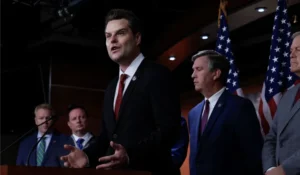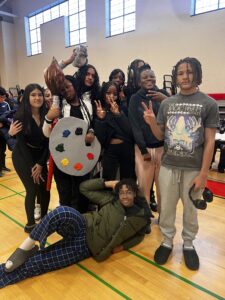Election 2016 May Have Ended, But The Political Pandemonium Is Endless

Republican presidential candidate Donald Trump waves to supporters after speaking at a campaign event in Dallas, Monday, Sept. 14, 2015. (AP Photo/LM Otero)
As the election of 2016 came to a conclusion this month, the social tensions amongst Americans only continue to intensify. Since Donald Trump was elected to the highest office of the United States, large crowds consisting of widespread demographics have turned out in the country’s largest urban cities to protest the results of the election. Within those crowds, in particular, are millennials and college students protesting against Donald Trump by using social media platforms that can publicize their message.
“Love trumps hate,” “This is what democracy looks like,” and “Not my president,” are chants that any millennial or teenager can come across while scrolling through their Instagram or Twitter feed. Older demographics are bombarded with these chants as they watch their favorite news network on television every night. While some people enjoy this coverage since they are against Donald Trump for his “unpredictable” and “degrading” rhetoric, other people are irritated, their nightly news time overwhelmed with this repetitious and contentious content.
Regardless of whether one supports Donald Trump or not, most can agree upon the fact that race relations have been impaired throughout the campaigning process. Hillary Clinton and Donald Trump proposed policies that sharply contrasted from each other. As a result, the people of the United States were often asked the following question throughout 2016–Clinton or Trump? Often, one’s religion, ethnicity, gender, age, and income all come into play when finding a person’s answer. Both candidates have made comments targeted towards African Americans, Muslims, and women in particular. Each candidate appeared to appeal to different demographics based off of exit polls.
CNN conducted an exit poll in which they had chosen a random sample of 24,537 people throughout the country. Of the males that participated, 53% voted for Trump. Of the females that participated, 54% for Clinton.This demonstrates that generally women found Clinton the more appealing choice. Of the whites that participated, 57% voted for Trump. Of the African Americans that participated, 88% voted for Clinton. Of the Latinos that participated, 65% voted for Clinton. While whites seem to be more divided in their pick, it is clear that racial minorities blatantly favored Clinton. Of the participants between the ages of 18-29, 55% voted for Clinton. Of the participants between the ages of 45-64, 53% voted for Trump. The younger age, as per usual, voted mostly for the more progressive candidate.
The CNN exits polls display the sharpest divide amongst the minorities of the country. Many African Americans and Latinos would feel more confident with Clinton in the White House. As a result, the protests continue. To these protestors, the popular vote, which Clinton won, indicates the true will of the people, despite the results of the Electoral College. The proposals that Donald Trump made during his campaign including “building a wall and making Mexico pay for it,” and, “a total and complete shutdown on Muslim immigration,” have left many racial, ethnic, and religious groups to feel uncomfortable with the idea of the President-elect in the White House. It is no wonder they are protesting.
As people continue to protest against Donald Trump, the opinions of the Hills West students linger in the hallways and classrooms. As protesters chant “this is what democracy looks like,” many students begin to question–is this truly what democracy looks like?
Many students do agree that “this is what democracy looks like.” As students have learned since middle school, the First Amendment to the Constitution of the United States guarantees the right for people to assemble and peacefully protest. Simran Awan, a Hills West sophomore, is one of many students that agree with this notion. “The type of hate and fear Trump has instilled in people through racist, misogynist, sexist, homophobic, and xenophobic comments throughout his campaign easily justifies these people’s intense protests.” Julia Jassey, also a Hills West sophomore, tends to disagree with the fact that it is justifiable for people to protest this outcome “I think that just as Donald Trump said in his 60 Minutes interview, if the situation were reversed (had Hillary Clinton won the election and the Trump supporters were rioting and protesting) then these actions would not be condoned…The same people who are protesting are the ones who didn’t vote.”
When asked about their opinions on those who sit for the pledge, which is another way dissenters have been protesting to the recent election, their opinions seemed to be very similar. Awan believed that such a form of protest went beyond the bounds of the controversial results of the 2016 election, stating, “I believe that by sitting for the pledge, you are disregarding and not acknowledging the thousands of soldiers and veterans that fought for this country and for our rights.” Jassey very much agreed, arguing that “people sitting for the pledge as a form of protest is, in my opinion, simply not okay. We stand for the pledge to honor our nation that keeps us safe and our veterans who died to give us freedom we take for granted”. Their viewpoints reveal that their values of honor and respect for the armed forces of the United States are persistent at such an early stage in their lives.
In addition to recognizing the opinions of students currently enrolled at Hills West, also knowing the opinion of alumni is imperative to understanding the full scope of viewpoints in our community. For example, Molly Kaye, a graduate from the class of 2015, and Briana Cohen, a graduate from the class of 2016, are two individuals that have utilized their right to freedom of speech.
Kaye was able to experience the environment of these protests in Washington D.C. and Baltimore. An environment of unity is described in one of her statements,“In the wake of the uptake of hate crimes across the country, people there just wanted to sing old hippie-ish folk songs and be together, one voice of peace made up from a few hundred people.” She continues, “No fights, no arrests as far as I’m aware. Just people using the same freedom of speech the president-elect loves to exercise.” Kaye’s motivation in being involved in the atmosphere of the protest was to “show solidarity with the people who are being hurt by the social repercussions of Trump’s percussions of Trump’s presidency.” “Regardless of who anyone voted for or politically leaned toward, this much hate speech and the prevalence of hate crimes must be condemned by the majority otherwise they will only get worse.”
Cohen was able to experience the environment of these protests at the Ohio State University. The “Not My President” peaceful protest was an event where protests were “intense due to how much of a politically involved campus” OSU is. Brianna has seen “both sides of the spectrum–the peaceful sit-ins and the violence that was broken up by the police.” These violent ones, she says, she merely watched from the sidelines and the protests she actually participated in were always peaceful. An environment similar to that of the protests in Washington D.C and Baltimore is prevalent. Cohen’s motivation was to “make everyone aware that violence and hate is not the way to solve problems and that it’s not okay to judge a person based on their gender, culture, religion, or skin tone.” These protests against hate speech and symbols are undeniably justified by the wave of hate speech from radical groups that has arisen in the wake of the election, namely the appearance of swastikas appearing on public property and the increase in offensive language targeting the LGBT community and American Muslims.
Both Kaye and Cohen believe that protesting the American flag is not disrespectful and that it is effective and appropriate. However, they both encourage protests to be peaceful. Kaye states, “If you believe that the country is not adhering to the principles it was built on,then do it, you’re not hurting anyone. That being said, I believe the people running in the streets burning effigies and lighting other things on fire, are hurting their case no matter how noble the message is. Peaceful protest and actually listening to the other side is the better, though slower way of creating change.” Cohen states, “They are not disrespectful–they are not shoving their views down other people’s throats and making a scene–because more and more people are discussing the issues that are taking place here in our country.”
The one common message that both the alumni and current students want the country to understand is that peaceful actions speak more than those intended to cause harm. In a nation that has faced one of its worst divisions in history, our core American values that are represented in the Constitution and laws of this country have to be honored by all Presidents.Values of justice, equality, and liberty must be reflected in every president’s actions and values, regardless of their political affiliation. Yet, if we expect this of our presidents, we should also expect this of ourselves.








